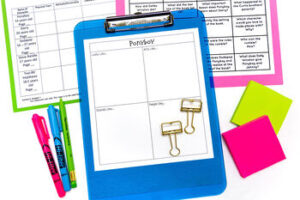States of matter is often one of the first “real” science units of the year for students. After learning about lab safety and measurement, they dive deep into learning about solids, liquids, and gases. No matter what time of year you teach this unit, it is important to make it engaging. Often, with state testing and all the other burdens that teaching brings, science can be left on the back burner or pressured into incorporating more and more literacy. There is a way to do both. In my science classroom, literacy is an integral part of the learning process, but so is a hands-on approach. Read on to learn about how I try to juggle the two without the students knowing.
Introducing your States of Matter Unit:
It is difficult to understand what kind of background knowledge students are bringing into your classroom. Two things that I do are:
- Engage them in some type of phenomena. This is great to work in the NGSS criteria into your curriculum. For this unit, I like this Youtube video that discusses how a liquid can show all three states of matter at relatively the same time. It sparks their interest.
- Introduce and discuss important vocabulary terms. This helps all students understand important concepts related to the unit.
- Some important terms should include solid, liquid, gas, condensation, evaporation.
Building on Student Knowledge:
I like to continually build upon their knowledge. This is also where I build upon their literacy skills. Students will read to learn about the characteristics and behavior of solids, liquids, and gases. Embedded in each reading are comprehension questions to continually assess their knowledge of these concepts. Literacy is critical, and learning to read and understand nonfiction text is an important skill for students to have.
Now comes the fun stuff. It is debatable whether you want to start with hands-on activities first or the meat and potatoes of learning about the topic. I find for my struggling learners, learning about the topic carries them farther.
Students will work in stations to complete different hands on activities. The videos give you ideas on how to quickly implement this into your classroom without breaking your budget.
Reviewing States of Matter:
Reviewing the concepts learned is important because they will use the information they learned from this unit and apply it to other teaching units like chemical and physical changes.
There are a few ways I like to review:
- Doodle sketch notes
- Color by number activities
- Flipbooks
- Task cards
Sketch Notes:
I like using sketch notes because it allows students to use both sides of their brains. The sketch notes that I use are similar to graphic organizers that allow students to get their thoughts down and doodle or sketch reminders around it. Give students time to color in their notes. All of this allows both sides of their brain to make connections to the concept. Since both sides are working, they make deeper connections to the task in front of them, which will instill a stronger comprehension of the topic.
Color by Number Activities:
These are great because they are self-checking. They are ideal for sub plans, homework, or as an extra help review. Often, you can also incorporate a holiday into your curriculum. My students love completing these, even in middle school!
Flipbooks:
I like using flipbooks in my units because they allow students to summarize the concepts they learned and have an easy-to-use review right at their fingertips. Students are again displaying their knowledge of states of matter, but they can also color it if they choose to again get both sides of that brain to work on an activity.
Task Cards:
Task cards are another popular way for students to review. Having a digital and printable version helps students to pick the path that they choose to study. Again, all those important concepts are being reviewed and reinforced to later build on their knowledge.
Final notes on Teaching States of Matter:
There are a lot of review activities that are spoken about here. I pick and choose the ones that will apply to my classroom that year. Some years I don’t have students who like coloring, which I need to respect, so I will guide them toward activities that I know they will enjoy.
The most important aspect of our teaching is to make sure our students are learning and enjoying the process. You want to tailor as much of the experience as you can to their learning styles, so observe them and see what they enjoy and how you can tap into that.
Have you used choice assignments with your students yet? Try them out for free by joining my science squad below.







